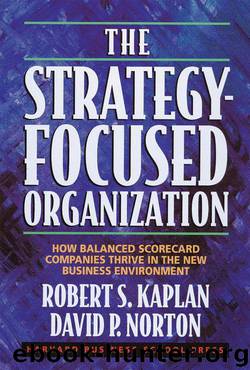The Strategy-Focused Organization: How Balanced Scorecard Companies Thrive in the New Business Environment by Robert S. Kaplan & David P. Norton

Author:Robert S. Kaplan & David P. Norton
Language: eng
Format: mobi
Publisher: Harvard Business Review Press
Published: 2000-09-12T14:00:00+00:00
Consultancy and business solutions
Information technology and systems
Business services (accounting, finance, real estate, procurement, etc.)
Human resources services
By mid-1999, SSI was delivering 6,000 different products or services to more than 3,000 individual customers, most within Shell but to some external customers as well. The units of SSI each had a Balanced Scorecard to define their strategic priorities (see Figure 7-3).
The linkage between any service provider in SSI and a customer was accomplished with a Service Level Agreement (SLA). Shared services had existed in Shell since 1985, and their operating costs had already been cut by 50 percent. The goal of SSI had to be broader than low-cost delivery. The SLA established a clear understanding between the internal customer and the service provider. With so many products and customers, SSI could not just offer a single level of service; some business units wanted “gold-plated” services, whereas others wanted the “nickel-plated” variety. Each customer evaluated the cost/value tradeoffs in the service and selected the service requirement to fit its business needs. The service provider, in turn, committed to enhancing its capacity to supply and deliver the desired services at agreed levels of cost and functionality. The providers would also strive to continuously improve their cost and service quality.
Measurements played a key role in implementing the SLA system. SSI developed unit-level costs for all of its products and services. These unit costs could be cost per transaction for repetitive activities, or a cost per hour for engineering and consultative activities. In addition to cost, however, the SLA included a Balanced Scorecard of performance measures relating to the following:
Download
This site does not store any files on its server. We only index and link to content provided by other sites. Please contact the content providers to delete copyright contents if any and email us, we'll remove relevant links or contents immediately.
The Brazilian Economy since the Great Financial Crisis of 20072008 by Philip Arestis Carolina Troncoso Baltar & Daniela Magalhães Prates(117709)
International Integration of the Brazilian Economy by Elias C. Grivoyannis(87557)
The Art of Coaching by Elena Aguilar(52867)
Flexible Working by Dale Gemma;(23238)
How to Stop Living Paycheck to Paycheck by Avery Breyer(19613)
The Acquirer's Multiple: How the Billionaire Contrarians of Deep Value Beat the Market by Tobias Carlisle(12206)
Thinking, Fast and Slow by Kahneman Daniel(12011)
The Radium Girls by Kate Moore(11890)
The Art of Thinking Clearly by Rolf Dobelli(10166)
Hit Refresh by Satya Nadella(9011)
The Compound Effect by Darren Hardy(8765)
Tools of Titans by Timothy Ferriss(8176)
Atomic Habits: Tiny Changes, Remarkable Results by James Clear(8149)
Turbulence by E. J. Noyes(7913)
A Court of Wings and Ruin by Sarah J. Maas(7596)
Change Your Questions, Change Your Life by Marilee Adams(7593)
Nudge - Improving Decisions about Health, Wealth, and Happiness by Thaler Sunstein(7511)
How to Be a Bawse: A Guide to Conquering Life by Lilly Singh(7359)
Win Bigly by Scott Adams(7061)
